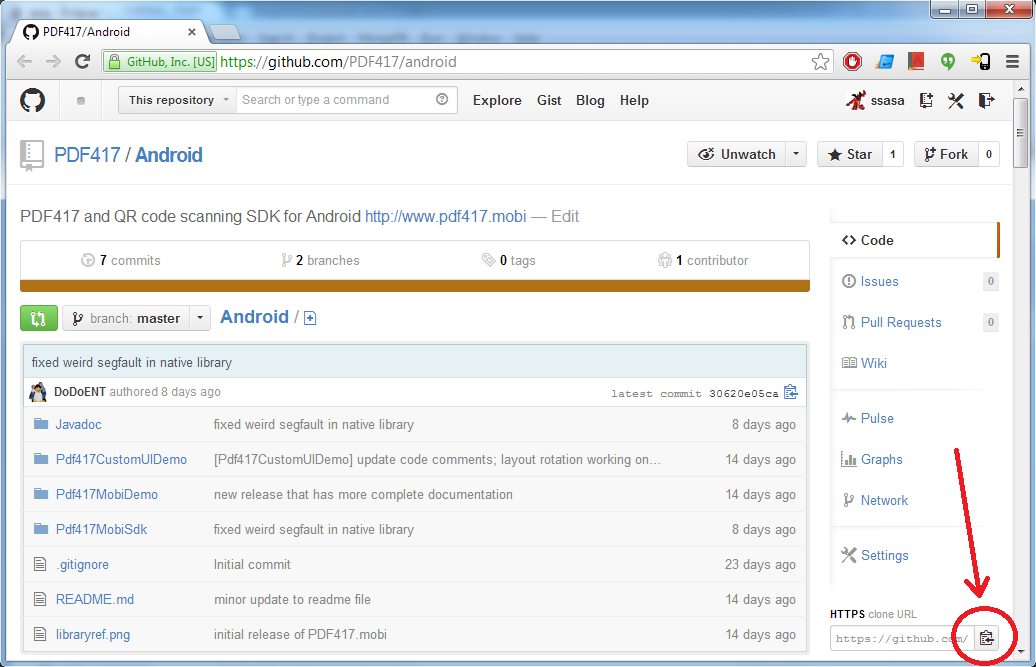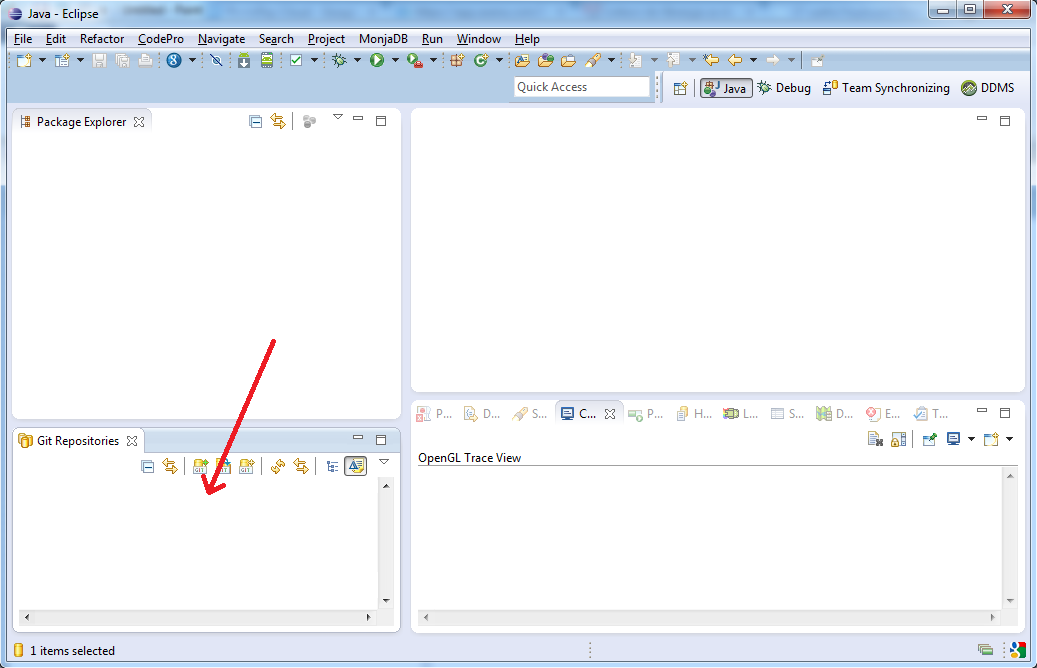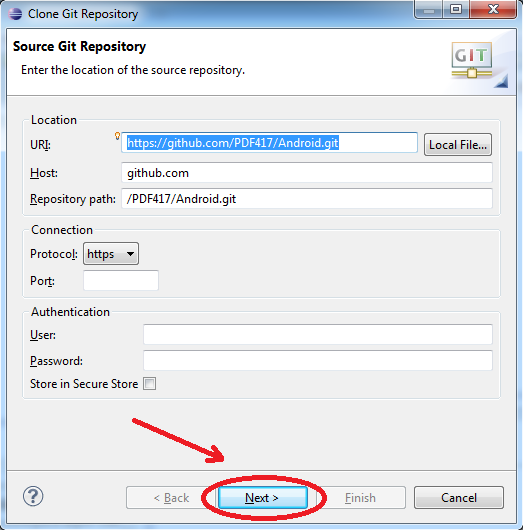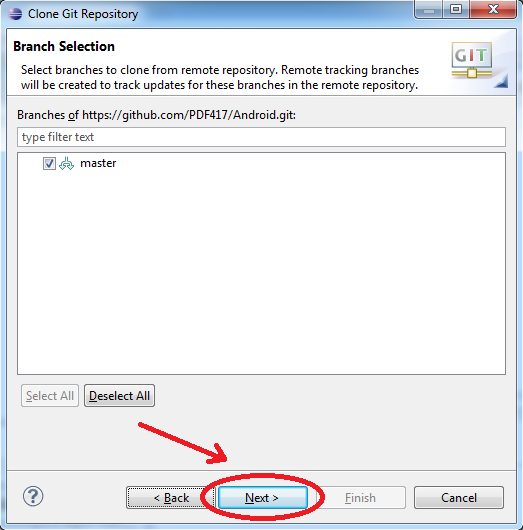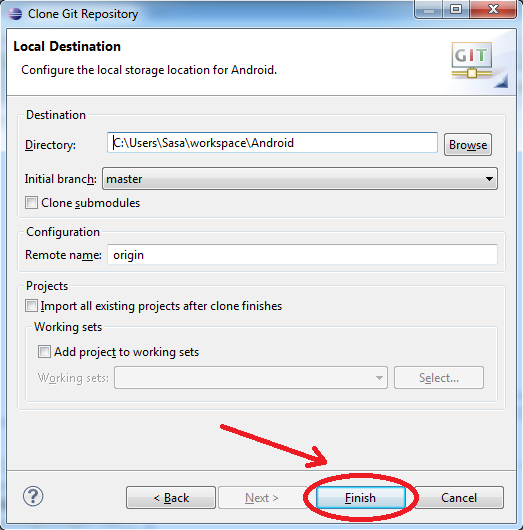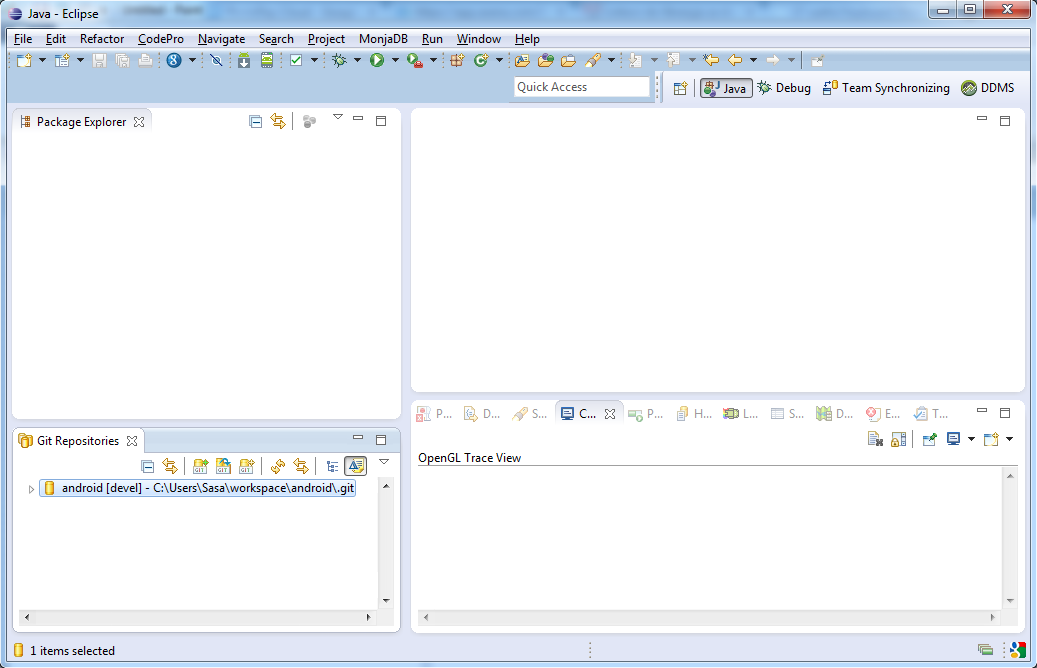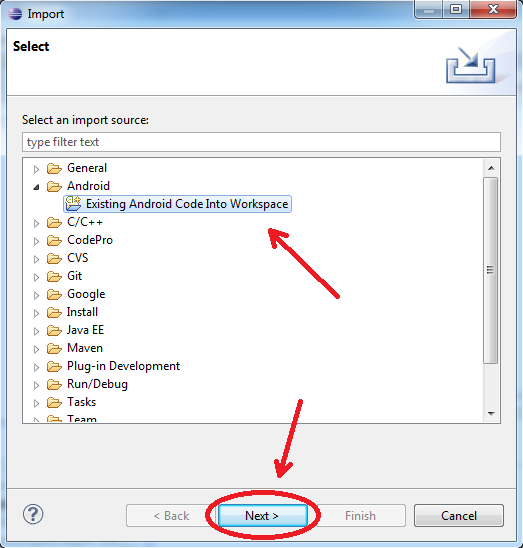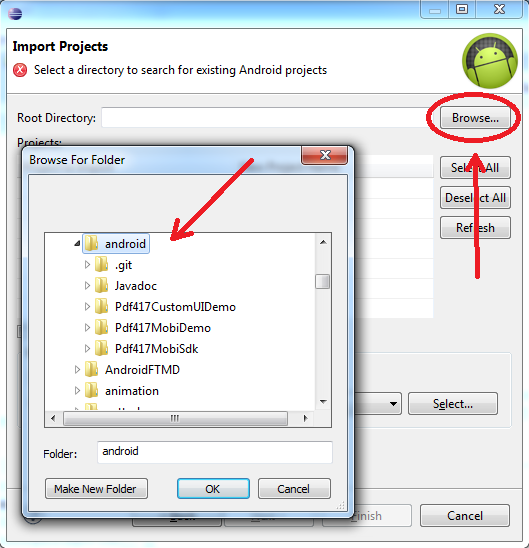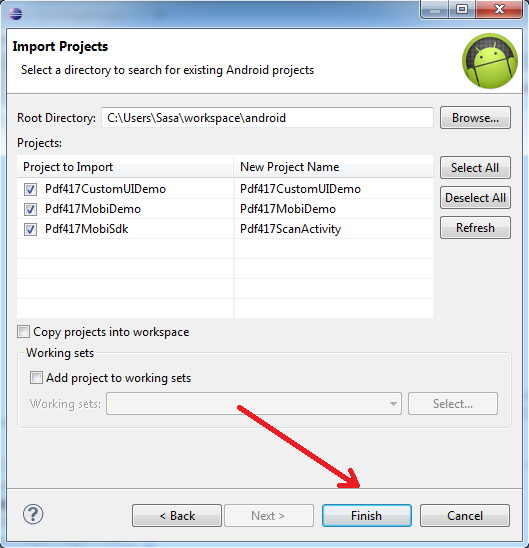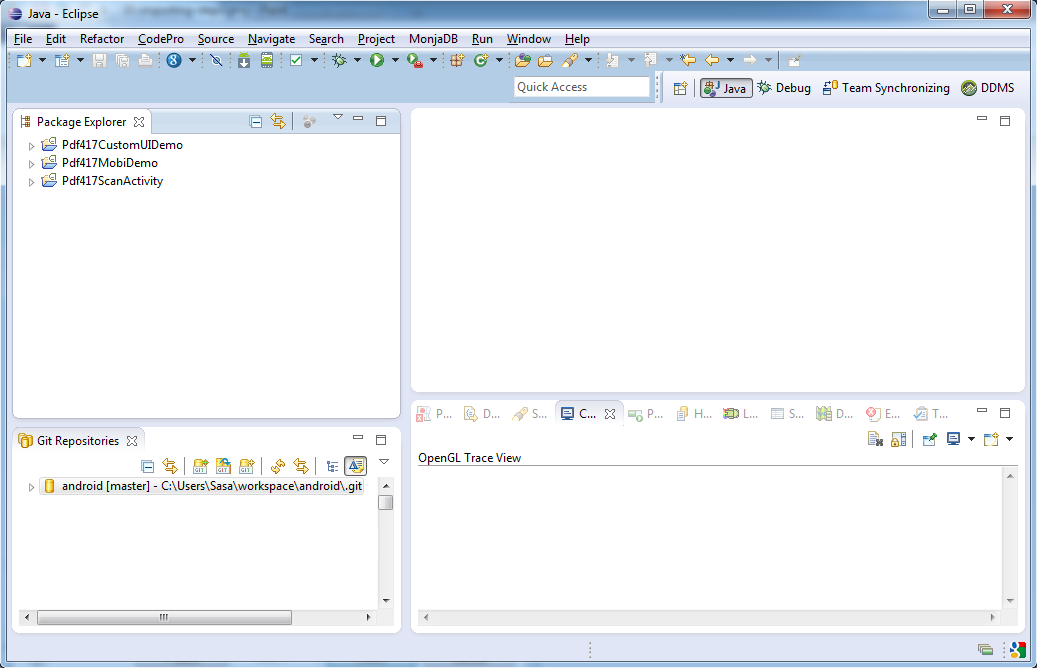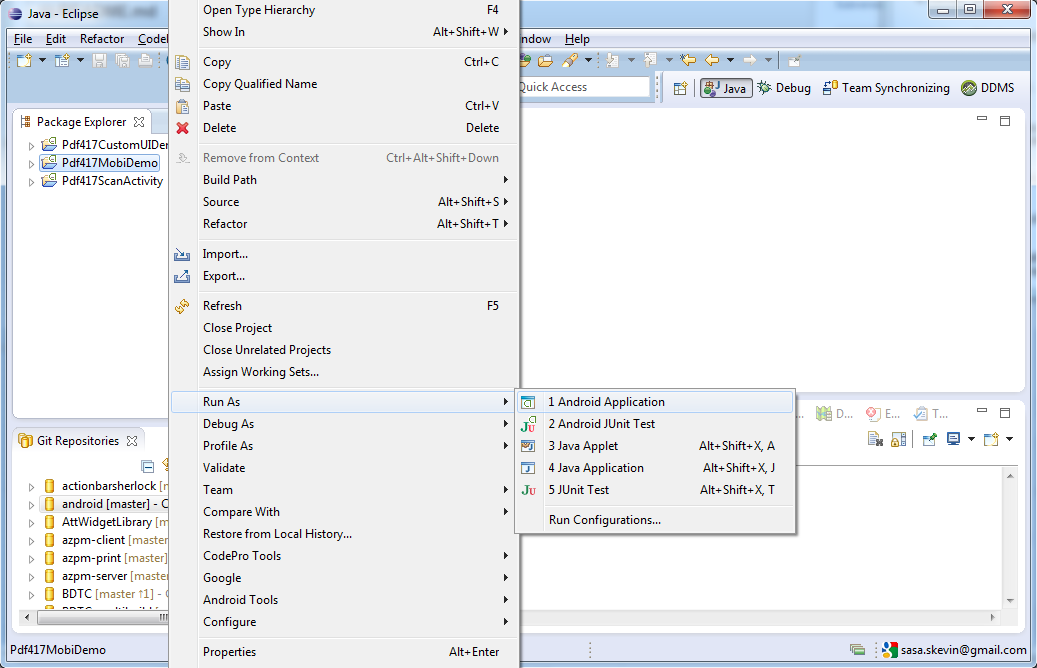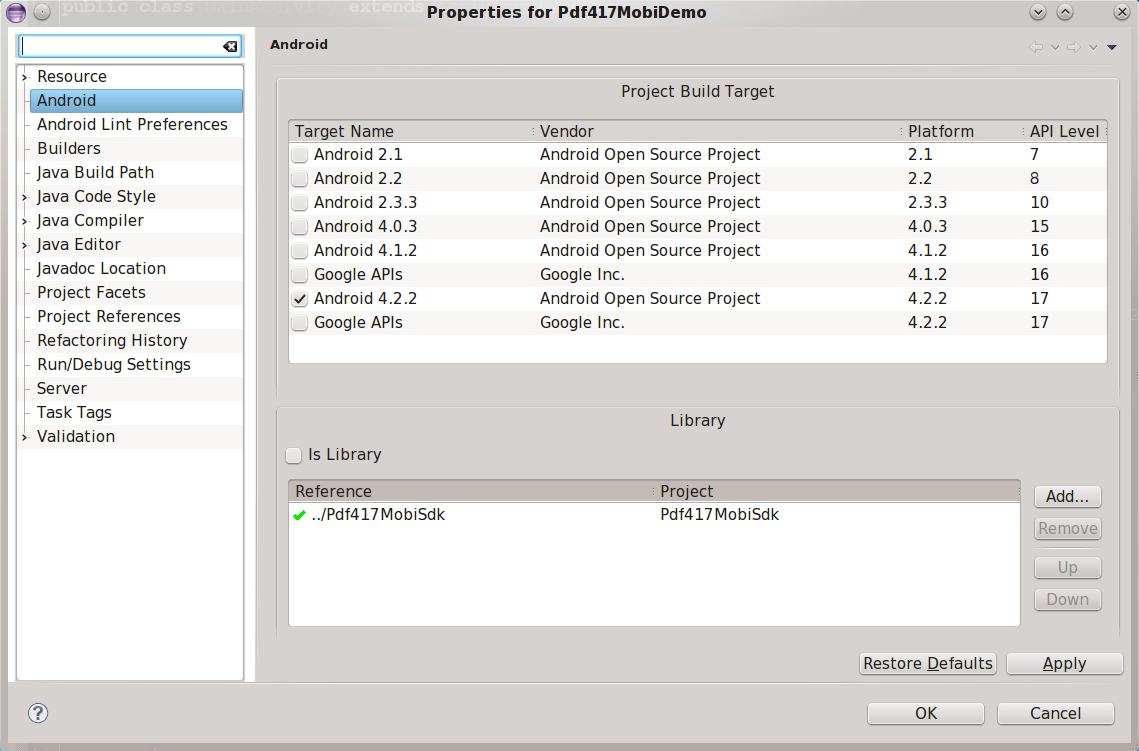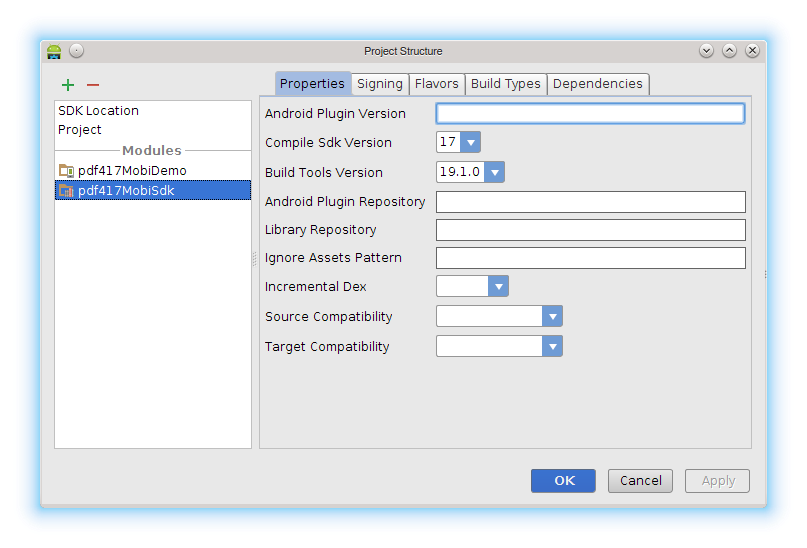The package contains two Android projects:
- Pdf417MobiSdk which is the library project which you include in your applications
- Pdf417MobiDemo demo application which demonstrates the usage of Pdf417MobiSdk
Pdf417.mobi is supported on Android SDK version 8 (Android 2.2) or later.
The project contains one Activity called ScanActivity that is responsible for camera control and barcode recognition
For more info visit http://pdf417.mobi
-
Go to https://github.com/PDF417/android and copy GitHub code URL as shown on picture:
-
Paste this URL to Eclipse Git Repository view:
-
Pass through "Clone Git Repository" by clicking Next, Next and Finish:
Cloned project shows as on this picture:
-
Right click with your mouse on Package Explorer in Eclipse and then on "Import...":
-
Select "Android -> Existing Android Code Into Workspace" and then "Next":
-
Click on "Browse..." and then search for "android" folder in your Eclipse workspace. Click OK.
-
Just click on Finish to import the three projects:
-
Three projects should appear:
-
Plugin your Android phone to USB, right click on "Pdf417MobiDemo", then "Run As" and "Android Application" and voila, the app is built, installed and run on your phone:
-
Pdf417MobiSdk is an Android Library project with classes, resources and everything required to function properly. Simply place the project into your workspace and reference it from your application project.
-
Edit your
AndroidManifest.xml. You should include camera and camera autofocus features:
<uses-permission android:name="android.permission.CAMERA" />
<uses-feature android:name="android.hardware.camera" />
<uses-feature android:name="android.hardware.camera.autofocus" />Also, add Pdf417ScanActivity entry:
<activity android:name="mobi.pdf417.activity.Pdf417ScanActivity" android:label="@string/app_name" android:screenOrientation="portrait" />-
Open your project using Android Studio, open Project structure dialog from File menu and select '+'. Proceed with 'Import existing project', select AndroidStudio/pdf417MobiSdk folder.
-
Edit your application build.gradle file, add dependency to pdf417MobiSdk library module:
dependencies { compile project(':pdf417MobiSdk') }
Maven repository for PDF417.mobi SDK is: http://pdf417.mobi/maven.
Open your pom.xml file and add these directives as appropriate:
<properties>
<pdf417mobi.version>3.0.1</pdf417mobi.version>
</properties>
<repositories>
<repository>
<id>pdf417repo</id>
<url>http://pdf417.mobi/maven</url>
</repository>
</repositories>
<dependencies>
<dependency>
<groupId>mobi.pdf417</groupId>
<artifactId>sdk-library</artifactId>
<version>${pdf417mobi.version}</version>
</dependency>
<dependency>
<groupId>mobi.pdf417</groupId>
<artifactId>sdk-resources</artifactId>
<type>aar</type>
<version>${pdf417mobi.version}</version>
</dependency>
<dependency>
<groupId>mobi.pdf417</groupId>
<artifactId>libPhotoPayBarcode</artifactId>
<type>so</type>
<classifier>armeabi</classifier>
<version>${pdf417mobi.version}</version>
</dependency>
<dependency>
<groupId>mobi.pdf417</groupId>
<artifactId>libPhotoPayBarcode</artifactId>
<type>so</type>
<classifier>armeabi-v7a</classifier>
<version>${pdf417mobi.version}</version>
</dependency>
<dependency>
<groupId>mobi.pdf417</groupId>
<artifactId>libPhotoPayBarcode</artifactId>
<type>so</type>
<classifier>x86</classifier>
<version>${pdf417mobi.version}</version>
</dependency>
<dependencies>Maven dependency has been tested on android-maven-plugin version 3.8.2.
If you are using ProGuard, add the following lines to your application proguard-project.txt file
-keep class net.photopay.** { *; }
-keepclassmembers class net.photopay.** {
*;
}
-keep class mobi.pdf417.** { *; }
-keepclassmembers class mobi.pdf417.** {
*;
}
-dontwarn android.hardware.**
-dontwarn android.support.v4.**
You can start scanning process by starting Pdf417ScanActivity activity with Intent initialized in the following way:
// Intent for Pdf417ScanActivity.class
Intent intent = new Intent(this, Pdf417ScanActivity.class);
// Start Activity
startActivityForResult(intent, MY_REQUEST_CODE);Pdf417ScanActivity will return the result to your activity via intent passed to your onActivityResult method after user click Use button in dialog shown after successful scan.
You can use pdf417 SDK free of change and without license key for development and non-commercial projects. Once you obtain a commercial license key from www.pdf417.mobi, you can set it with EXTRAS_LICENSE_KEY intent extra like this:
// set the license key
intent.putExtra(Pdf417ScanActivity.EXTRAS_LICENSE_KEY, "Enter_License_Key_Here");License key is bound to package name of your application. For example, if you have license key that is bound to mobi.pdf417 app package, you cannot use the same key in other applications. However, if you purchase Premium license, you will get license key that can be used in multiple applications. This license key will then not be bound to package name of the app. Instead, it will be bound to the license owner string that needs to be provided to the library together with the license key. To provide license owner string, use the EXTRAS_LICENSE_OWNER intent extra like this:
// set the license key
intent.putExtra(Pdf417ScanActivity.EXTRAS_LICENSE_KEY, "Enter_License_Key_Here");
intent.putExtra(Pdf417ScanActivity.EXTRAS_LICENSE_OWNER, "Enter_License_Owner_Here");If you do not provide license owner, license key will be validated against current application package name and will fail to unlock the library.
You can also set additional settings to Intent used for initializing the Pdf417ScanActivity:
-
If you want sound to be played after the scanning process ends, use
EXTRAS_BEEP_RESOURCEto set the resource ID of the sound, like thisintent.putExtra(Pdf417ScanActivity.EXTRAS_BEEP_RESOURCE, R.raw.beep);
-
If you want to always use the highest available camera resolution, set
EXTRAS_ALWAYS_USE_HIGH_RESto true. This is by default enabled for all devices that support at least 720p camera preview frame size. To set this parameter, use the following code snippet:intent.putExtra(Pdf417ScanActivity.EXTRAS_ALWAYS_USE_HIGH_RES, true);
-
if you want to use front facing camera instead of back facing camera, you should set
EXTRA_CAMERA_TYPEtoCAMERA_FRONTFACE, like this:intent.putExtra(Pdf417ScanActivity.EXTRAS_CAMERA_TYPE, (Parcelable)CameraType.CAMERA_FRONTFACE)
-
if you want to set scanning region, you can do it in the following way:
// define scanning region // first parameter of rectangle is x-coordinate represented as percentage // of view width*, second parameter is y-coordinate represented as percentage // of view height*, third parameter is region width represented as percentage // of view width* and fourth parameter is region height represented as percentage // of view heigth* // // * view width and height are defined in current context, i.e. they depend on // screen orientation. If you allow your ROI view to be rotated, then in portrait // view width will be smaller than height, whilst in landscape orientation width // will be larger than height. This complies with view designer preview in eclipse ADT and android studio. // If you choose not to rotate your ROI view, then your ROI view will be layout either // in portrait or landscape, depending on setting for your camera activity in AndroidManifest.xml Rectangle roi = new Rectangle(0.2f, 0.1f, 0.5f, 0.4f); intent.putExtra(Pdf417ScanActivity.EXTRAS_ROI, roi); // if you intent to rotate your ROI view, you should set the EXTRAS_ROTATE_ROI extra to true // so that PDF417.mobi can adjust ROI coordinates for native library when device orientation // change event occurs intent.putExtra(Pdf417ScanActivity.EXTRAS_ROTATE_ROI, true);
-
if you want to optimize camera parameters for near object scanning, you should set
EXTRAS_OPTIMIZE_CAMERA_FOR_NEAR_SCANNINGtotrue. When camera parameters are optimized for near object scanning, macro focus mode will be preferred over autofocus mode. Thus, camera will have easier time focusing on to near objects, but might have harder time focusing on far objects. If you expect that most of your scans will be performed by holding the device very near the object, turn on that parameter. By default, this parameter is set tofalse. Set the parameter like this:intent.putExtra(Pdf417ScanActivity.EXTRAS_OPTIMIZE_CAMERA_FOR_NEAR_SCANNING, true)
-
You can use
Pdf417MobiSettingsobject to tweak additional scanning parameters. This is entirely optional. If you don't send this object via intent, default scanning parameters will be used - this means both QR and PDF417 codes will be scanned and default camera overlay will be shown. For example, you could set settings as in following example:Pdf417MobiSettings sett = new Pdf417MobiSettings(); // set this to true to enable PDF417 scanning sett.setPdf417Enabled(true); // Set this to true to scan even barcode not compliant with standards // For example, malformed PDF417 barcodes which were incorrectly encoded // Use only if necessary because it slows down the recognition process sett.setUncertainScanning(true); // Set this to true to scan barcodes which don't have quiet zone (white area) around it // Use only if necessary because it drastically slows down the recognition process sett.setNullQuietZoneAllowed(true); // Set this to true to enable parsing of data from US Driver's License barcodes // This feature is available only if license key permits it. sett.setDecodeUSDriverLicenseData(true); // set this to true to enable QR code scanning sett.setQrCodeEnabled(true); // set this to true to prevent showing dialog after successful scan sett.setDontShowDialog(false); // if license permits this, remove Pdf417.mobi logo overlay on scan activity // if license forbids this, this option has no effect sett.setRemoveOverlayEnabled(true); // put settings as intent extra intent.putExtra(BaseBarcodeActivity.EXTRAS_SETTINGS, sett);
Obtaining the scanned data is done in the onActivityResult method. If the recognition returned some results, result code returned will be BaseBarcodeActivity.RESULT_OK. Optionally, if user tapped the Copy button in dialog, result code returned will be BaseBarcodeActivity.RESULT_OK_DATA_COPIED to indicate that barcode data is copied into clipboard. For example, your implementation of this method could look like this:
@Override
protected void onActivityResult(int requestCode, int resultCode, Intent data) {
super.onActivityResult(requestCode, resultCode, data);
if(requestCode==MY_REQUEST_CODE && resultCode==BaseBarcodeActivity.RESULT_OK) {
// read scan result
Pdf417MobiScanData scanData = data.getParcelableExtra(BaseBarcodeActivity.EXTRAS_RESULT);
// read scanned barcode type (PDF417 or QR code)
String barcodeType = scanData.getBarcodeType();
// read the data contained in barcode
String barcodeData = scanData.getBarcodeData();
// determine if returned data is uncertain
boolean uncertainData = scanData.isResultUncertain();
// in case US Driver's License data was parsed, you can access the fields
// in the following way
if(scanData instanceOf USDLScanData) {
USDLScanData usdlData = (USDLScanData) scanData;
// handle data
}
// ask user what to do with data
Intent intent = new Intent(Intent.ACTION_SEND);
intent.setType("text/plain");
intent.putExtra(Intent.EXTRA_TEXT, barcodeType + ": " + barcodeData);
startActivity(Intent.createChooser(intent, getString(R.string.UseWith)));
}
}You can also obtain the list of all data that have been scanned (if there is more than one). For that matter, you need to use BaseBarcodeActivity.EXTRAS_RESULT_LIST key as shown in following example:
@Override
protected void onActivityResult(int requestCode, int resultCode, Intent data) {
super.onActivityResult(requestCode, resultCode, data);
if(requestCode==MY_REQUEST_CODE && resultCode==BaseBarcodeActivity.RESULT_OK) {
// read scan result
ArrayList<Pdf417MobiScanData> scanDataList = data.getParcelableArrayList(BaseBarcodeActivity.EXTRAS_RESULT_LIST);
for(Pdf417MobiScanData scanData : scanDataList) {
// do whatever you need to do with data
}
}
}If US Driver's License decoding was used, you can also obtain parsed fields by casting Pdf417MobiScanData into USDLScanData class, and then use its methods to obtain driver's license fields:
Pdf417MobiScanData scanData;
if(scanData instanceOf USDLScanData) {
USDLScanData usdlData = (USDLScanData) scanData;
String aamvaVersion = usdlData.getField(USDLScanData.kAamvaVersionNumber);
}To see the list of available keys and their descriptions for obtaining the driver's licenses fields, see Keys for obtaining US Driver's license data.
In order to obtain raw barcode data, you need to obtain BarcodeDetailedData structure by calling getBarcodeRawData method of Pdf417ScanData instance returned via BaseBarcodeActivity.EXTRAS_RESULT extra in result intent. This structure will contain list of barcode elements. Each barcode element contains byte array with its raw data and type of that raw data. Type of raw data can be either ElementType.TEXT_DATA or ElementType.BYTE_DATA. ElementType.TEXT_DATA defines that byte array can be interpreted as string, whilst ElementType.BYTE_DATA defines that byte array is probably not string. However, you can always convert all data to string and you will then get the same string that you can obtain by calling getBarcodeData. For example, you can use that structure like this:
@Override
protected void onActivityResult(int requestCode, int resultCode, Intent data) {
super.onActivityResult(requestCode, resultCode, data);
if(requestCode==MY_REQUEST_CODE && resultCode==BaseBarcodeActivity.RESULT_OK) {
// read scan result
Pdf417MobiScanData scanData = data.getParcelableExtra(BaseBarcodeActivity.EXTRAS_RESULT);
// read raw barcode data
BarcodeDetailedData rawData = scanData.getBarcodeRawData();
// get list of barcode elements
List<BarcodeElement> elems = rawData.getElements();
// log the amount of elements
Log.i(TAG, "Number of barcode elements is " + elems.size());
// now iterate over elements
for(int i=0; i<elems.size(); ++i) {
BarcodeElement elem = elems.get(i);
// get the barcode element type
ElementType elemType = elem.getElementType();
// get raw bytes of the element
byte[] rawBytes = elem.getElementBytes();
// do with that data whatever you want
// for example print it
Log.i(TAG, "Element #" + i + " is of type: " + elemType.name());
StringBuilder sb = new StringBuilder("{");
for(int j=0; j<rawBytes.length; ++j) {
sb.append((int)rawBytes[j] & 0x0FF);
if(j!=rawBytes.length-1) {
sb.append(", ");
}
}
sb.append("}");
Log.i(TAG, sb.toString());
}
}
}Additionally, if you don't need the whole per element information, you can just use getAllData method of BarcodeDetailedData class to obtain byte array of the whole barcode. Note that you need to be able to extract useful information from such a byte array on your own.
This section will discuss how to embed Pdf417MobiView into your scan activity and perform scan.
- First make sure that
Pdf417MobiViewis a member field in your activity. This is required because you will need to pass all activity's lifecycle events toPdf417MobiView. - It is recommended to keep your scan activity in one orientation, such as
portraitorlandscape. Settingsensoras scan activity's orientation will trigger full restart of activity whenever device orientation changes. This will provide very poor user experience because both camera and PDF417.mobi native library will have to be restarted every time. There are measures for this behavious and will be discussed later. - In your activity's
onCreatemethod, create a newPdf417MobiView, define its settings and listeners and then call itscreatemethod. After that, add your views that should be layouted on top of camera view. - Override your activity's
onResume,onPause,onStartandonStopmethods and callPdf417MobiView'slifecycle methodsresume,pause,startandstop. This will ensure correct camera and native resource management.
Here is the minimum example of integration of Pdf417MobiView as the only view in your activity:
public class MyScanActivity extends Activity implements Pdf417MobiScanResultListener {
private Pdf417MobiView mPdf417MobiView;
@Override
protected void onCreate(Bundle savedInstanceState) {
// create PhotoPayView
mPdf417MobiView = new Pdf417MobiView(this);
/**
* Prepare settings for recognition.
*/
Pdf417MobiSettings sett = new Pdf417MobiSettings();
sett.setPdf417Enabled(true);
sett.setDecodeUSDriverLicenseData(true);
sett.setQrCodeEnabled(true);
// set scanning settings
mPdf417MobiView.setScanSettings(sett);
// set license key
mPdf417MobiView.setLicenseKey("your license key here");
// scan result listener will be notified when scan result gets available
mPdf417MobiView.setPdf417MobiScanResultListener(this);
mPdf417MobiView.create();
setContentView(mPdf417MobiView);
}
@Override
protected void onResume() {
super.onResume();
// you need to pass all activity's lifecycle methods to Pdf417MobiView
mPdf417MobiView.resume();
}
@Override
protected void onStart() {
super.onStart();
// you need to pass all activity's lifecycle methods to Pdf417MobiView
mPdf417MobiView.start();
}
@Override
protected void onPause() {
super.onPause();
// you need to pass all activity's lifecycle methods to Pdf417MobiView
mPdf417MobiView.pause();
}
@Override
protected void onStop() {
super.onStop();
// you need to pass all activity's lifecycle methods to Pdf417MobiView
mPdf417MobiView.stop();
}
@Override
public void onConfigurationChanged(Configuration newConfig) {
super.onConfigurationChanged(newConfig);
// you need to pass all activity's lifecycle methods to Pdf417MobiView
mPdf417MobiView.changeConfiguration(newConfig);
}
@Override
public void onScanningDone(ArrayList<Pdf417MobiScanData> scanDataList) {
// this method is from Pdf417MobiScanResultListener and will be called when scanning completes
// multiple scan results may be returned, depending on scanning settings used for initialization of view
}
}If activity's screenOrientation property in AndroidManifest.xml is set to sensor, fullSensor or similar, activity will be restarted every time device changes orientation from portrait to landscape and vice versa. While restarting activity, its onPause, onStop and onDestroy methods will be called and then new activity will be created anew. This is a potential problem for scan activity because in its lifecycle it controls both camera and native library - restarting the activity will trigger both restart of the camera and native library. This is a problem because changing orientation from landscape to portrait and vice versa will be very slow, thus degrading a user experience. We do not recommend such setting.
For that matter, we recommend setting your scan activity to either portrait or landscape mode and handle device orientation changes manually. To help you with this, Pdf417MobiView supports adding child views to it that will be rotated regardless of activity's screenOrientation. You add a view you wish to be rotated (such as view that contains buttons, status messages, etc.) to Pdf417MobiView with addChildView method. The second parameter of the method is a boolean that defines whether the view you are adding will be rotated with device. To define allowed orientations, implement OrientationAllowedListener interface and add it to Pdf417MobiView with method setOrientationAllowedListener. This is the recommended way of rotating camera overlay.
However, if you really want to set screenOrientation property to sensor or similar and want Android to handle orientation changes of your scan activity, then we recommend to set configChanges property of your activity to orientation|screenSize. This will tell Android not to restart your activity when device orientation changes. Instead, activity's onConfigurationChanged method will be called so that activity can be notified of the configuration change. In your implementation of this method, you should call changeConfiguration method of Pdf417MobiView so it can adapt its camera surface and child views to new configuration. Note that on Android versions older than 4.0 changing of configuration will require restart of camera, which can be slow.
Important
If you use sensor or similar screen orientation for your scan activity there is a catch. No matter if your activity is set to be restarted on configuration change or only notified via onConfigurationChanged method, if your activity's orientation is changed from portrait to reversePortrait or from landscape to reverseLandscape or vice versa, your activity will not be notified of this change in any way - it will not be neither restarted nor onConfigurationChanged will be called - the views in your activity will just be rotated by 180 degrees. This is a problem because it will make your camera preview upside down. In order to fix this, you first need to find a way how to get notified of this change and then you should call changeConfiguration method of Pdf417MobiView so it will correct camera preview orientation.
The complete reference of Pdf417MobiView is available in Javadoc. The usage example is provided in Pdf417CustomUIDemo demo app provided with SDK. This section just gives a quick overview of PhotoPayView's most important methods.
This method should be called in activity's onCreate method. It will initialize Pdf417MobiView's internal fields. This method must be called after all other settings are already defines, such as listeners and scanning settings. After calling this method, you can add child views to Pdf417MobiView with method addChildView(View, boolean).
This method should be called in activity's onStart method. It will initialize background processing thread and start native library initialization on that thread.
This method should be called in activity's onResume method. It will trigger background initialization of camera.
This method should be called in activity's onPause method. It will stop the camera, but will keep native library loaded.
This method should be called in activity's onStop method. It will deinitialize native library and free all resources that are no longer necessary.
This method should be called in activity's onConfigurationChanged method. It will adapt camera surface to new configuration without the restart of the activity. See Scan activity's orientation for more information.
With this method you can define which camera on device will be used. Default camera used is back facing camera.
With this method you can set the Pdf417MobiSettings object. This object contains information about what and how will scan be performed. For more information about methods of that object, consult Javadoc.
With this method you can set a OrientationAllowedListener which will be asked if current orientation is allowed. If orientation is allowed, it will be used to rotate rotatable views to it and it will be passed to native library so that recognizers can be aware of the new orientation.
With this method you can set a RecognizerViewEventListener which will be notified when certain recognition events occur, such as when object has been detected.
With this method you can set a Pdf417MobiScanResultListener which will be notified when recognition completes. After recognition completes, Pdf417MobiView will pause its scanning loop and to continue the scanning you will have to call resumeScanning method. In this method you can obtain data from scanning results. For more information see Obtaining the scanning results.
With this method you can set a CameraEventsListener which will be notified when various camera events occur, such as when camera preview has started, autofocus has failed or there has been an error while starting the camera.
This method pauses the scanning loop, but keeps both camera and native library initialized. This method is called internally when scan completes.
With this method you can resume the paused scanning loop.
With this method you can add your own view on top of PhotoPayView. PhotoPayView will ensure that your view will be layouted exactly above camera preview surface (which can be letterboxed if aspect ratio of camera preview size does not match the aspect ratio of PhotoPayView). Boolean parameter defines whether your view should be rotated with device orientation changes. The rotation is independent of host activity's orientation changes and allowed orientations will be determined from OrientationAllowedListener. See also Scan activity's orientation for more information why you should rotate your views independently of activity.
This method returns true if camera thinks it has focused on object. Note that camera has to be loaded for this method to work.
This method requests camera to perform autofocus. If camera does not support autofocus feature, method does nothing. Note that camera has to be loaded for this method to work.
This method returns true if camera supports torch flash mode. Note that camera has to be loaded for this method to work.
If torch flash mode is supported on camera, this method can be used to enable/disable torch flash mode. If operation is successful, method returns true. Note that camera has to be loaded for this method to work.
Since version 3.0.0, Pdf417.mobi is distributed with both ARMv6, ARMv7 and x86 native library binaries. Older versions were built only for ARM architectures.
ARMv7 architecture gives the ability to take advantage of hardware accelerated floating point operations and SIMD processing with NEON. This gives Pdf417.mobi a huge performance boost on devices that have ARMv7 processors. Most new devices (all since 2012.) have ARMv7 processor so it makes little sense not to take advantage of performance boosts that those processors can give.
x86 architecture gives the ability to obtain native speed on x86 android devices, like Prestigio 5430. Without that, Pdf417.mobi will not work on such devices, or it will be run on top of ARM emulator that is shipped with device - this will give a huge performance penalty.
However, there are some issues to be considered:
- ARMv7 processors understand ARMv6 instruction set, but ARMv6 processors do not understand ARMv7 instructions.
- if ARMv7 processor executes ARMv6 code, it does not take advantage of hardware floating point acceleration and does not use SIMD operations
- ARMv7 build of native library cannot be run on devices that do not have ARMv7 compatible processor (list of those old devices can be found here)
- neither ARMv6 nor ARMv7 processors understand x86 instruction sets
- x86 processors do not understand neither ARMv6 nor ARMv7 instruction set
- however, some x86 android devices ship with the builtin ARM emulator - such devices are able to run ARM binaries (both ARMv6 and ARMv7) but with performance penalty. There is also a risk that builtin ARM emulator will not understand some specific ARM instruction and will crash.
Pdf417MobiSdk android library contains both ARMv6, ARMv7 and x86 builds of native library. Those build are found in subfolder libs:
libs/armeabicontains native libraries for ARMv6 processor architecturelibs/armeabi-v7acontains native libraries for ARMv7 processor arhitecturelibs/x86contains native libraries for x86 processor architecture
By default, when you integrate Pdf417MobiSdk into your app (see above for instructions), your app will contain native builds for all processor architectures. Thus, Pdf417.mobi will work on ARMv6 and x86 devices and will use ARMv7 features on ARMv7 devices. However, the size of your application will be rather large.
If your final app is too large because of PDF417.mobi, you can decide to remove one processor architecture from Pdf417MobiSdk. You can do this just by deleting appropriate folder inside Pdf417MobiSdk that contains native library for specific processor architecture:
- to remove ARMv6 support, delete folder
libs/armeabi - to remove ARMv7 support, delete folder
libs/armeabi-v7a - to remove x86 support, delete folder
libs/x86
However, removing a processor architecture has some consequences:
- by removing ARMv6 support PDF417.mobi will not work on devices that have ARMv6 processors.
- by removing ARMv7 support, PDF417.mobi will work on both devices that have ARMv6 and ARMv7 processor. However, on ARMv7 processors, hardware floating point and SIMD acceleration will not be used, thus making PDF417.mobi much slower.
- by removing x86 support, PDF417.mobi will not work on devices that have x86 processor, except in situations when devices have ARM emulator - in that case, PDF417.mobi will work, but will be slow
Our recommendation is to include both ARMv6, ARMv7 and x86 versions into your app - it will work on all devices and will provide best user experience. However, if you really need to reduce the size of your app, we recommend releasing three versions of your app - one version with only ARMv6 version of PDF417.mobi for old devices, one version with only ARMv7 version of PDF417.mobi for new devices and one version with only x86 version of PDF417.mobi for those rare x86 devices.
Important note
If you are combining PDF417.mobi library with some other libraries that contain native code into your application, make sure you match the architectures of all native libraries. For example, if third party library has got only ARMv6 and x86 versions, you must use exactly ARMv6 and x86 versions of PDF417.mobi with that library, but not ARMv7. Using ARMv7 will most definitely crash your app on loading time on some devices because it will try to load all its native dependencies in same preferred architecture - for example Nexus 4 preferres ARMv7 native libraries so it will see that there is a PDF417.mobi ARMv7 native library and will load it. After that, it will try to load ARMv7 version of your third party library which does not exist - therefore app will crash with UnsatisfiedLinkException.
-
Adding new language
Pdf417.mobi can easily be translated to other languages. The
resfolder in Pdf417MobiSdk library project has foldervalueswhich containsstrings.xml- this file contains english strings. In order to make e.g. Croatian translation, create a foldervalues-hrin your project and put the copy ofstrings.xmlinside it. Then, open that file and change the english version strings into Croatian version. -
Modifying other resources.
You can also modify other resources, such as colours and camera overlay layouts. To change a colour, simply open res/values/colors.xml and change the values of colours. Creating custom camera overlay in your own scan activity is explained in demo application called
Pdf417CustomUIDemo. In order to be able to directly usePdf417MobiView, you must buy a commercial license.License key is bound to package name of application which integrates the library. Demo license key works for package name
mobi.pdf417. To integrate library properly into your application, obtain a license from PDF417.mobi web.
In case of problems with using the SDK, you should do as follows:
-
Enable logging to get the ability to see what is library doing. To enable logging, put this line in your application:
net.photopay.util.Log.setLogLevel(net.photopay.util.Log.LogLevel.LOG_VERBOSE);
After this line, library will display as much information about its work as possible. Make sure to remove this line in your production code as lots of log outputs may slow down the performance of library.
If you cannot solve problems by yourself, do not hesitate to contact us at pdf417@photopay.net. Make sure you include the logs when contacting us to minimise the time to find and correct a bug. Also, if having problems reading specific barcodes, please send us high resolution scans of those problematic barcodes.
In the package is the working demo application in which you can experiment with integration details. Also, in the package there is Pdf417CustomUIDemo
If you have problems running the demo, try multiple refreshes, clean builds, close/open projects and Android Tools -> Fix Project Properties. In many situations this helps.
Also, feel free to contact us at pdf417@photopay.net.
